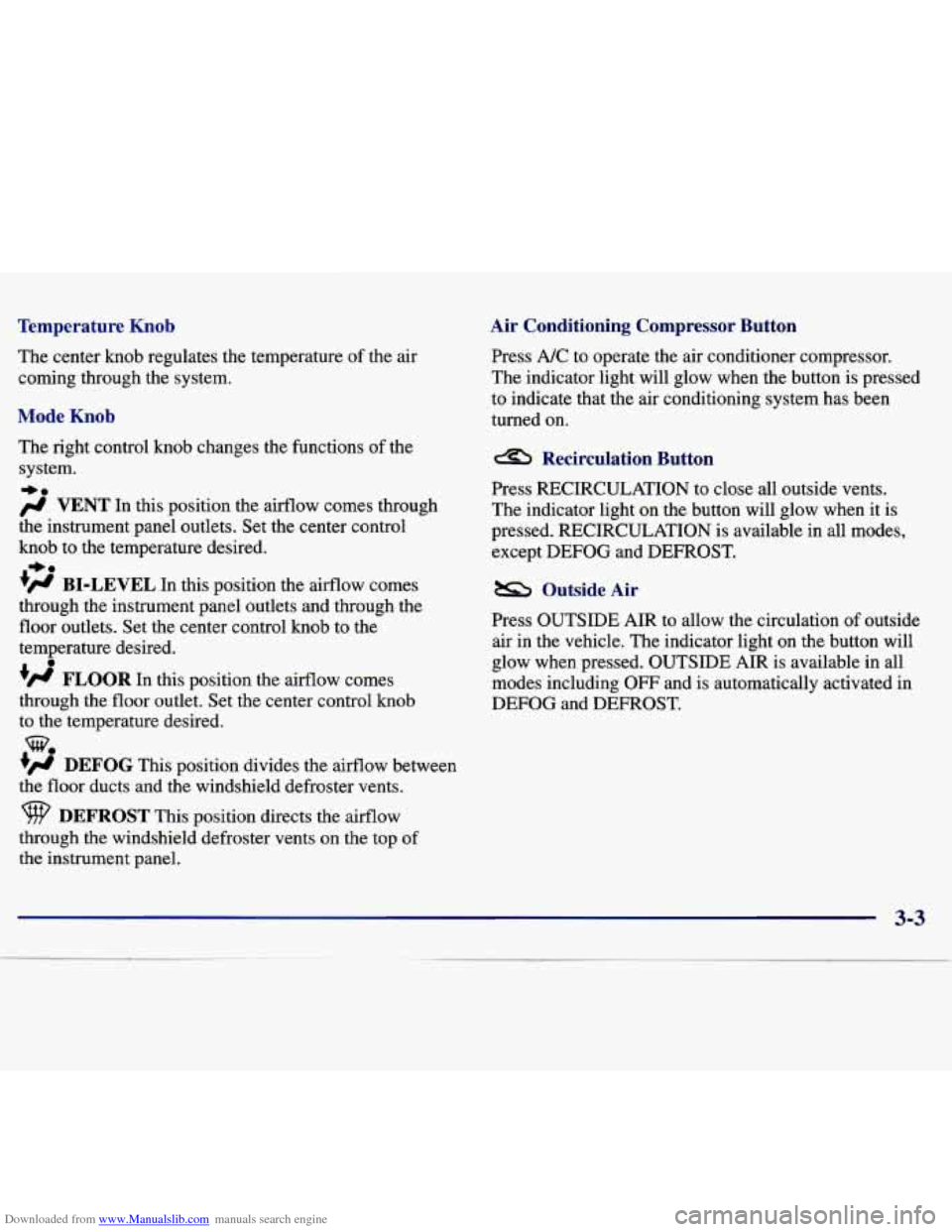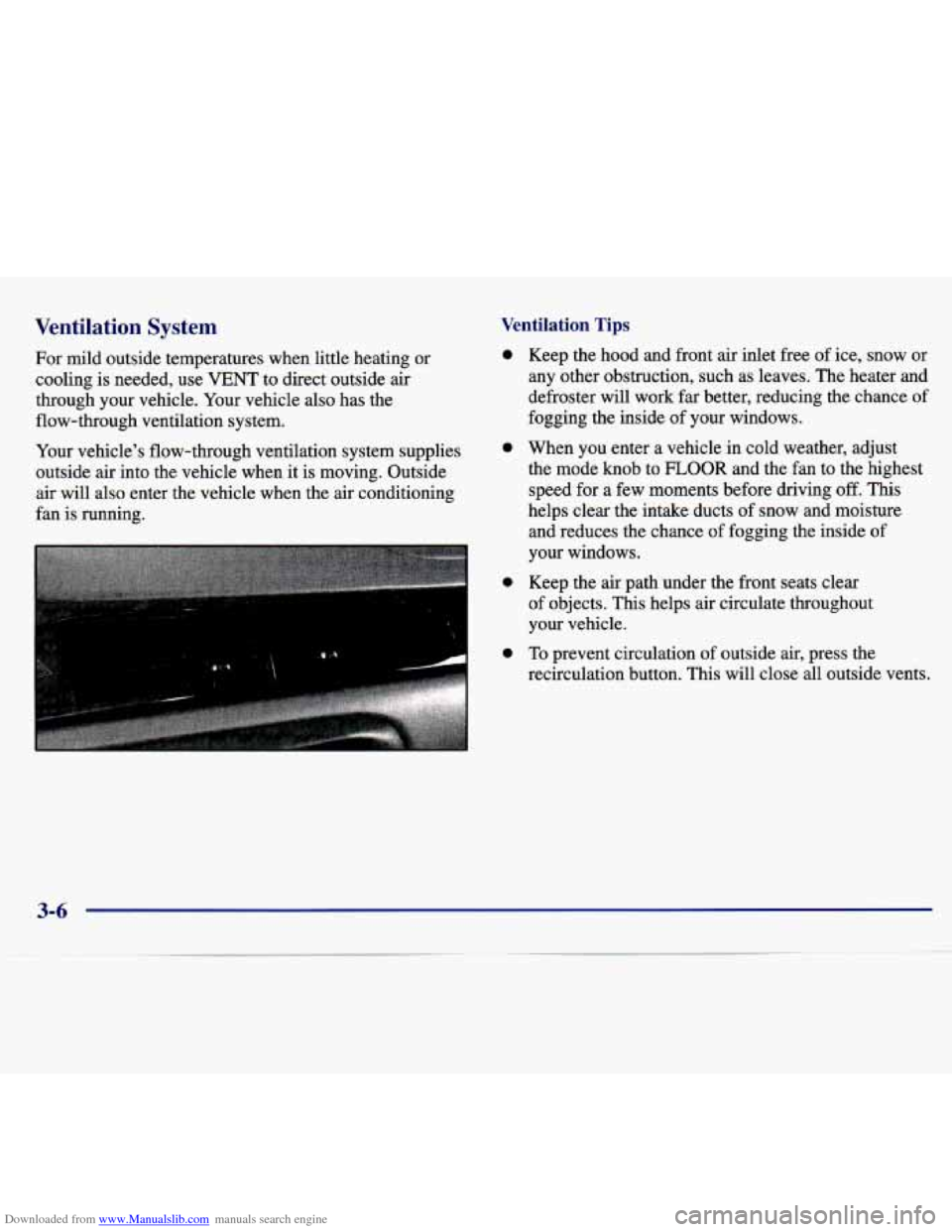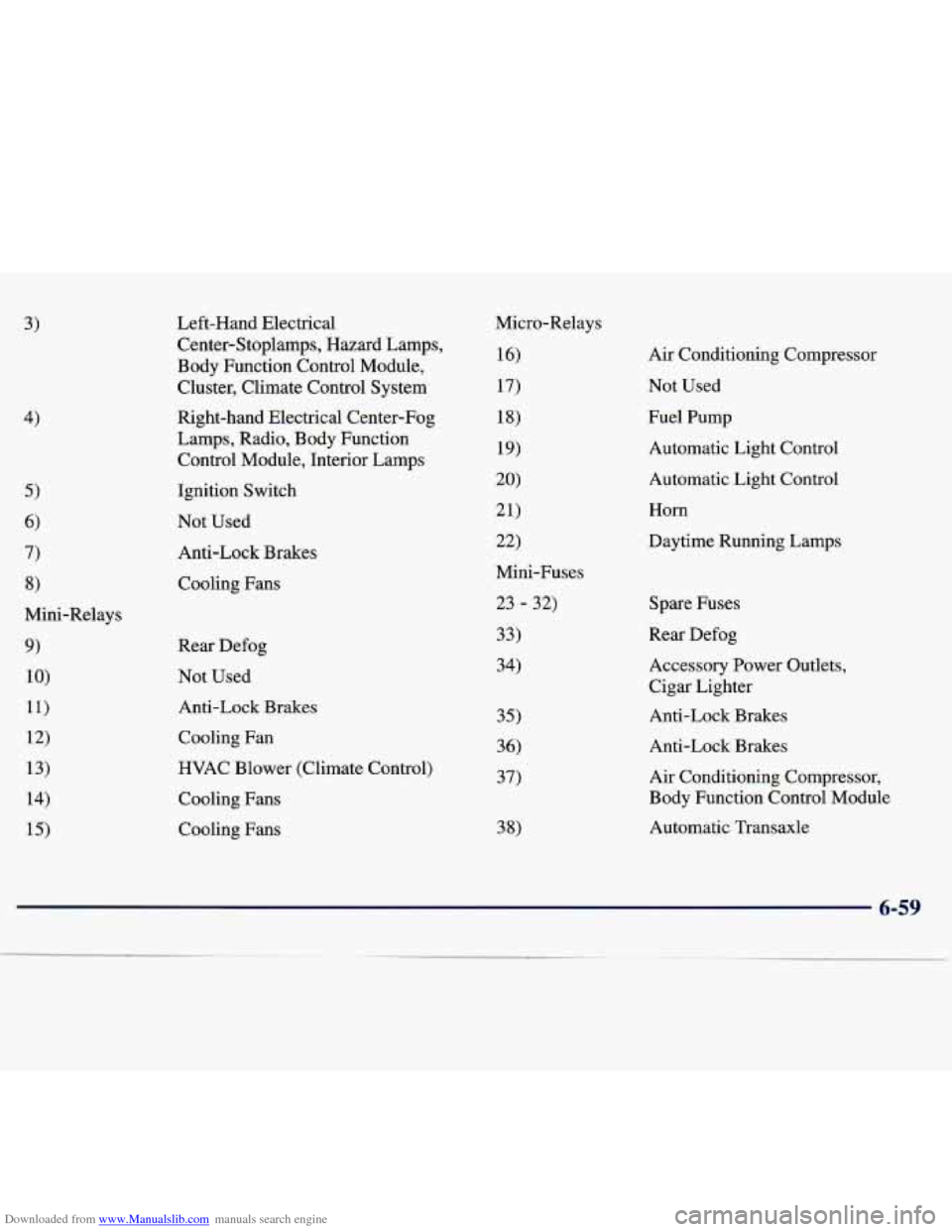1997 CHEVROLET MALIBU air conditioning
[x] Cancel search: air conditioningPage 122 of 354

Downloaded from www.Manualslib.com manuals search engine U Section 3 Comfort Controls and Audio Systems
In this section, you'll find out how to operate the comfort control and audio systems offered with your Chevrolet. Be
sure to read about the particular systems supplied with your vehicle.
3-2
3-2
3-4
3-4
3-5
3-6
3-7
3-7
3-9 3-13 Climate Controls
Air Conditioning
Heating
Tips for Defogging and Defrosting
Rear Window Defogger
Ventilation System and Tips Setting the Clock
A" Stereo
A" Stereo with Cassette and ATC
CD Adapter Kits
3- 14
3-18
3- 19
3-22
3-22
3-22 3-23
3-24
3-24 A" Stereo with CD and ATC
Remote Cassette Player
Theft-Deterrent Feature
Adding Sound Equipment to Your Vehicle
Understanding Radio Reception Tips About Your Audio System
Care of Your Cassette Tape Player
Care of Your Compact Discs
Antenna
3-1
Page 123 of 354

Downloaded from www.Manualslib.com manuals search engine Comfort Controls
This section tells you how to make your air system
work for you. The climate control system with air
conditioning uses ozone-friendly
R- 134a refrigerant.
With these systems, you can control the ventilation and heating in your vehicle. Your vehicle also has
the flow-through ventilation system described later
in this section.
Climate Control System with
Air Conditioning
8 Fan Knob
The left knob selects the force of air you want. Turn the
knob to the right to increase fan speed and
to the left to
decrease fan speed. To
turn the fan off (which will also
turn the climate control system
off), turn the knob all the
way to the left. In any other setting, the fan will run
continuously. The fan must be
on to run the air
conditioning compressor.
3-2
Page 124 of 354

Downloaded from www.Manualslib.com manuals search engine Temperature Knob
The center knob regulates the temperature of the air
coming through the system.
Mode Knob
The right control knob changes the functions of the
system.
-0
/J VENT In this position the airflow comes through
the instrument panel outlets. Set the center control
knob to the temperature desired.
*H BI-LEVEL In this position the airflow comes
through the instrument panel outlets and through the
floor outlets. Set the center control knob to the
temperature desired.
+’ FLOOR In this position the airflow comes
through the floor outlet. Set the center control
knob
to the temperature desired.
+H DEFOG This position divides the airflow between
the floor ducts and the windshield defroster vents.
DEFROST This position directs the airflow
+o
e
we
through the windshield defroster vents on the top of
the instrument panel.
Air Conditioning Compressor Button
Press A/C to operate the air conditioner compressor.
The indicator light will glow when the button is pressed
to indicate that the air conditioning system has been
turned on.
Recirculation Button
Press RECIRCULATION to close all outside vents.
The indicator light on the button will glow when it is
pressed. RECIRCULATION is available in all modes,
except DEFOG and DEFROST.
Outside Air
Press OUTSIDE AIR to allow the circulation of outside
air in the vehicle. The indicator light on the button will
glow when pressed. OUTSIDE AIR is available in all
modes including
OFF and is automatically activated in
DEFOG and DEFROST.
3-3
Page 125 of 354

Downloaded from www.Manualslib.com manuals search engine Air Conditioning Heating
On cold
days, use FLOOR with the temperature knob
all the way in the red area. The system will bring in
outside air, heat it and send it to the floor ducts.
The
air conditioner and heater work best if you keep
your windows closed while using them. Your vehicle also has the flow-through ventilation system described
later in this section.
On very hot days, open the windows long enough to
let hot inside air escape. This reduces the time it takes
for your vehicle to cool down, which should help
fuel economy.
On cool, but sunny days, the sun may warm your upper
body, but your lower body may not be
warm enough.
You can use
BI-LEVEL with the temperature knob in
the middle and the A/C button pushed in. The system
will bring in outside air and direct slightly warmer air
to your lower body.
For quick cool-down on very hot days, use
VENT with
the temperature knob all the way in the blue area and the
A/C and RECIRCULATION buttons pressed. If this
setting is used for long periods of time, the air in your
vehicle may become too dry.
For normal cooling on hot days, use
VENT with the
temperature knob in the blue area and the
NC button
pushed
in. The system will bring in outside air and cool it.
Your vehicle has heat ducts that are directed toward the
rear seat. Keep the area under the front seats clear
of
obstructions so the heated air can reach the rear seat
passengers.
If your vehicle has an engine coolant heater, you can use it to help your system provide warm air faster when it’s
cold outside
(0°F (-18°C) or lower). An engine coolant
heater warms the coolant your engine and heating system use to provide heat. See “Engine Coolant
Heater” in the Index.
Defogging and Defrosting Windows
Your system has two settings for clearing the front and
side windows. For each setting, adjust the temperature
control as desired.
To defrost the windows quickly, rotate the temperature control knob
all the way in the red area. Use DEFROST
and adjust the fan to the highest speed. To warm
passengers while keeping the windows clean, use DEFOG.
3-4
Page 127 of 354

Downloaded from www.Manualslib.com manuals search engine Ventilation System Ventilation Tips
For mild outside temperatures when little heating or
cooling is needed, use VENT to direct outside
air
through your vehicle. Your vehicle also has the
flow-through ventilation system.
Your vehicle’s flow-through ventilation system supplies
outside air into the vehicle when
it is moving. Outside
air will also enter the vehicle when the air conditioning
fan
is running.
0
0
0
0
Keep the hood and front air inlet free of ice, snow or
any other obstruction, such as leaves. The heater and
defroster will work far better, reducing
. : chance of
fogging the inside of your windows.
When you enter a vehicle in cold weather, adjust the mode
knob to FLOOR and the fan to the highest
speed for a few moments before driving
off. This
helps clear the intake ducts of snow and moisture
and reduces the chance
of fogging the inside of
your windows.
Keep the air path under the front seats clear
of objects.
This helps air circulate throughout
your vehicle.
To prevent circulation of outside air, press the
recirculation button. This will close all outside vents.
3-6
Page 186 of 354

Downloaded from www.Manualslib.com manuals search engine Driving On Grades
NOTICE:
Do not tow on steep continuous grades exceeding
6 miles (9.6 km). Extended, higher than normal
engine and transaxle temperatures may result
and damage your vehicle. Frequent stops are
very important to allow the engine and transaxle
to cool.
Reduce speed and shift to a lower gear before you start
down a long or steep downgrade. If you don’t shift
down, you might have to use your brakes
so much that
they would get hot and no longer work well.
On a long uphill grade, shift down and reduce your
speed to around
45 mph (70 kmh) to reduce the
possibility of engine and transaxle overheating.
Parking on Hills
You really should not park your vehicle, with a trailer
attached, on a hill.
If something goes wrong, your rig
could start to move. People can be injured, and both
your vehicle and the trailer can be damaged.
But if you ever have to park your rig
on a hill, here’s
how to do it:
1. Apply your regular brakes, but don’t shift into
2. Have someone place chocks under the trailer wheels.
3. When the wheel chocks are in place, release the
regular brakes until the chocks absorb the load.
brake and shift into PARK
(P).
PARK (P) yet.
4. Reapply the regular brakes. Then apply your parking
5. Release the regular brakes.
Pay attention to the engine coolant gage. If the indicator
is in the red area, turn off the air conditioning (if you
have this option) to reduce engine load (see “Engine
Overheating” in the Index).
4-39
Page 222 of 354

Downloaded from www.Manualslib.com manuals search engine 0 Section 6 Service a-- - Aopearance Care
Here you will fiid information about the care of your Chevrolet. This section begins with service and fuel
information, and then it shows how to check important fluid and lubricant levels. There is also technical information
about your vehicle, and
a part devoted to its appearance care.
6-2
6-3 6-5
6-5
6-7
6-
12
6-18
6-18
6-23
6-24
6-28
6-29
6-29
6-35
6-36 Doing
Your Own Service Work
What Kind of Fuel to Use
Using Fuel in Foreign Countries
Where to Put the Fuel and Filling the Tank
Checking Things Under the Hood
Checking Your Engine Oil
Automatic Transaxle Fluid
Engine Coolant
Where to
Fill the Windshield Washer Fluid
Important Brake Information
Information on Your Vehicle's Battery
Tips on Vehicle Storage
Bulb Replacement Procedures
Windshield Wiper Blade Replacement
How and When to Check Tire Inflation 6-39
6-42
6-44
6-47
6-48
6-50
6-5 1
6-52
6-53
6-54 6-55
6-6 1
6-6
1
' 6-62
i 6-62 When
it is
Time to Buy New Tires
Wheel Alignment
Cleaning the Inside of Your Vehicle
Care of the Safety Belts
Cleaning the Outside
of Your Vehicle
How to Clean Aluminum Wheels
Underbody Maintenance
Recommended Appearance Care Materials
Your Vehicle Identification Number (VIN)
The Electrical System
Fuses and Circuit Breakers
Replacement Bulb Types for Your Vehicle
Capacities and Specifications
Air Conditioning Specifications
Normal Replacement
Parts
Page 280 of 354

Downloaded from www.Manualslib.com manuals search engine 3)
4)
Left-Hand Electrical
Center-Stoplamps, Hazard Lamps,
Body Function Control Module, Cluster, Climate Control System
Right-hand Electrical Center-Fog
Lamps, Radio, Body Function Control Module, Interior Lamps
Ignition Switch
Not Used
Anti-Lock Brakes
Cooling Fans
Rear Defog
Not Used Anti-Lock
Brakes
Cooling Fan
HVAC Blower (Climate Control)
Cooling Fans
Cooling Fans
35)
36)
37)
3
8)
Air Conditioning Compressor
Not Used
Fuel Pump
Automatic Light Control Automatic Light Control
Horn
Daytime Running Lamps
Spare Fuses
Rear Defog Accessory Power Outlets,
Cigar Lighter
Anti-Lock Brakes
Anti-Lock Brakes
Air Conditioning Compressor,
Body Function Control Module
Automatic Transaxle
6-59